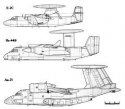asif iqbal
Lieutenant General
yes and also fixed wing AWACS taking off from a carrier is another thing
one of the most challenging aspects of carrier operations is to get a fixed wing AWACS off it
huge radar balanced on a aircraft which is small taking off from a ski jump or carrier in the middle of the ocean
massive deal and theres a good reason outside US hardly anyone has managed it and even less try and attempt such a project
hugely under stated but one of the most important components in carrier air wing
China demonstrating such capability will certainly raise the stakes
one of the most challenging aspects of carrier operations is to get a fixed wing AWACS off it
huge radar balanced on a aircraft which is small taking off from a ski jump or carrier in the middle of the ocean
massive deal and theres a good reason outside US hardly anyone has managed it and even less try and attempt such a project
hugely under stated but one of the most important components in carrier air wing
China demonstrating such capability will certainly raise the stakes





